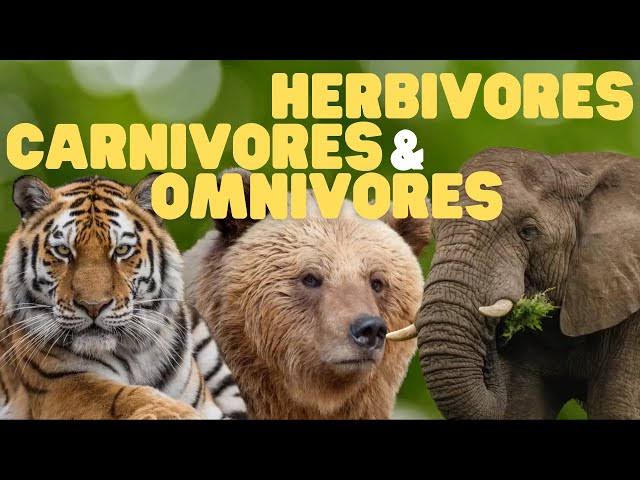
Understanding the Digestive Systems of Herbivores, Carnivores, and Omnivores
The digestive systems of herbivores, carnivores, and omnivores are uniquely adapted to their dietary habits. Herbivores thrive on plant-based diets with specialized fermentation processes, carnivores rely on protein-rich meat digestion, and omnivores consume both plant and animal matter. This article explores these digestive differences, their mechanisms, and how they impact feeding strategies and nutritional needs.
🐶 Pet Star
10 min read · 28, Jan 2025

Digestive System of Herbivores
Herbivores primarily consume plant material, which is rich in fiber but challenging to digest. Their digestive systems are designed to extract nutrients from cellulose through fermentation.
1. Anatomy and Features
- Teeth: Flat molars for grinding plant fibers.
- Saliva: Contains enzymes to start breaking down carbohydrates.
- Stomach and Intestines: Large and specialized for fermentation.
2. Types of Herbivores
- Ruminants: Animals like cows, sheep, and goats have multi-chambered stomachs.
- Rumen: Houses microbes that break down cellulose.
- Reticulum: Collects smaller particles for further digestion.
- Omasum: Absorbs water and nutrients.
- Abomasum: Functions like a true stomach, using enzymes.
- Non-Ruminants: Horses and rabbits rely on hindgut fermentation.
- Fermentation occurs in the cecum and colon.
3. Challenges and Adaptations
- Fiber Digestion: Relies on microbial symbiosis to produce volatile fatty acids (VFAs) for energy.
- Slow Digestion: Ensures thorough breakdown of plant material.
Digestive System of Carnivores
Carnivores consume meat, which is nutrient-dense and easier to digest than plant material. Their digestive systems are simpler and shorter.
1. Anatomy and Features
- Teeth: Sharp canines for tearing flesh and carnassial teeth for shearing.
- Stomach: Highly acidic (low pH) to break down proteins and kill bacteria.
- Short Intestines: Reflect the ease of protein and fat digestion.
2. Mechanisms of Digestion
- Protein Breakdown: Begins in the stomach with pepsin and continues in the small intestine.
- Fat Absorption: Occurs in the small intestine with bile from the liver aiding fat emulsification.
3. Adaptations
- High Digestive Efficiency: Carnivores absorb most nutrients from their diet with minimal waste.
- Frequent Fasting: Many carnivores can endure extended periods without food due to their ability to store energy as fat.
Digestive System of Omnivores
Omnivores eat both plant and animal matter, requiring versatile digestive systems.
1. Anatomy and Features
- Teeth: Combination of sharp canines for meat and flat molars for grinding plants.
- Moderate Stomach Acidity: Allows digestion of diverse foods.
- Intermediate Intestine Length: Balances the needs of both plant and protein digestion.
2. Adaptability
Omnivores can switch between different food sources based on availability. Their digestive systems handle mixed diets effectively, though they may not be as efficient as specialized herbivores or carnivores.
Importance of Feeding According to Digestive Type
- Herbivores:
- Require high-fiber diets like hay, grass, and leafy vegetables.
- Diets must support microbial populations for fermentation.
- Carnivores:
- Need protein-rich foods like meat and fish.
- Avoid high-fiber diets, as they lack enzymes to break down cellulose.
- Omnivores:
- Benefit from a mixed diet of grains, fruits, vegetables, and proteins.
- Diet variety helps meet all nutritional needs.
Challenges in Digestive Health
- Herbivores:
- Risk of bloat or colic from sudden diet changes.
- Poor-quality forage can lead to nutrient deficiencies.
- Carnivores:
- Over-reliance on processed diets may cause obesity.
- Lack of variety can result in nutrient imbalances.
- Omnivores:
- Improper balance of plant and animal foods can lead to health issues.
Q1: Why do herbivores have long digestive tracts?
Ans) Herbivores need long digestive tracts to break down fibrous plant material through fermentation, which takes time and microbial assistance.
Q2: How does the stomach acidity differ between carnivores and herbivores?
Ans) Carnivores have highly acidic stomachs to digest meat and kill pathogens, while herbivores have less acidic stomachs suited for fermenting plants.
Q3: Can omnivores survive on only plants or meat?
Ans) While omnivores can survive temporarily on a single food type, long-term health requires a balanced diet of both plant and animal sources.
Q4: What role do microbes play in herbivore digestion?
Ans) Microbes in the digestive system ferment cellulose, converting it into energy-rich compounds like volatile fatty acids.
Q5: Why do carnivores have shorter intestines?
Ans) Carnivores’ protein-based diets are easier to digest and do not require prolonged fermentation, so shorter intestines suffice.
Similar Articles
Find more relatable content in similar Articles

Virtual Vet Visits: Are Online Consultations Reliable?..
As pet healthcare embraces dig.. Read More

Composting Pet Waste: A Greener Way to Clean Up...
As pet ownership continues to .. Read More

Pets and Mental Health: The Science Behind Emotional H..
Discover the profound impact o.. Read More

Social Media for Pets: Turning Your Pet into a Digital..
From playful puppies to charis.. Read More
Explore Other Categories
© 2024 Copyrights by rPets. All Rights Reserved.